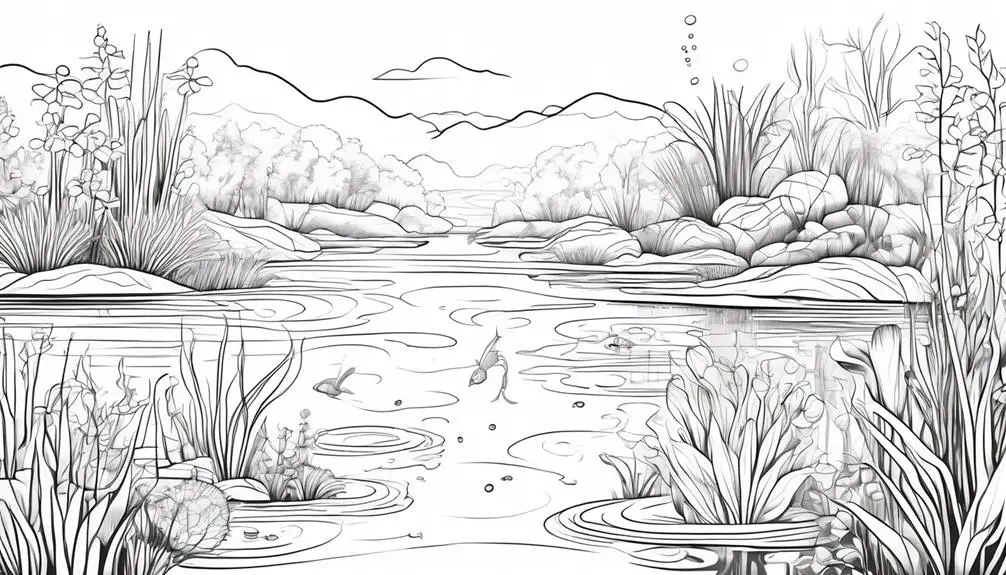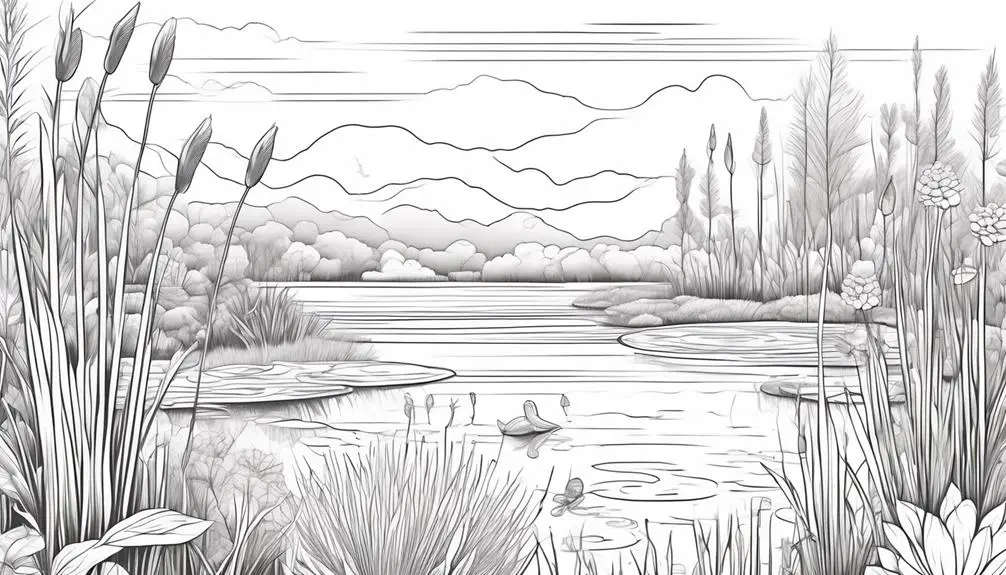Did you know that the water cycle, an essential process for sustaining life on Earth, can also have significant environmental impacts? From water pollution to habitat destruction, the consequences can be far-reaching.
But fear not, because there are ways to mitigate these impacts and protect our precious water resources. In this discussion, we will explore practical and effective strategies that you can implement to safeguard the water cycle and preserve the health of our planet.
So, let's dive in and discover how we can make a positive difference together.
Key Takeaways
- Climate change can disrupt the water cycle, leading to more frequent droughts and flooding.
- Growing population and increased water demand pose a risk to water resources.
- Severe storms can overwhelm drainage systems, leading to pollution and overflows.
- Implementing sustainable water management practices, such as efficient irrigation techniques and rainwater harvesting systems, can help mitigate the environmental impacts of the water cycle.
Understanding the Water Cycle Stages
To truly understand the water cycle stages, you must delve into the intricate processes that govern the movement and transformation of water on our planet. The water cycle, also known as the hydrological cycle, is a continuous process that involves the movement of water between the Earth's surface, atmosphere, and underground. It's crucial to comprehend these stages as they play a vital role in maintaining the Earth's water balance and sustaining life as we know it.
The water cycle consists of four main stages: evaporation, condensation, precipitation, and collection. It begins with evaporation, where the sun's heat causes water from oceans, lakes, and rivers to turn into vapor and rise into the atmosphere. As the vapor cools, it condenses into tiny water droplets, forming clouds. These water droplets then combine and grow larger until they fall back to the Earth's surface as precipitation, which can be in the form of rain, snow, sleet, or hail. Finally, the collected water either seeps into the ground, replenishing groundwater supplies, or flows into rivers and eventually returns to the oceans.
Understanding the water cycle stages is essential for various reasons. It helps us predict and manage water resources, as well as understand weather patterns and climate change. Additionally, comprehending the water cycle allows us to mitigate environmental impacts such as droughts, floods, and water pollution. By studying this process, we can develop strategies to conserve water, protect ecosystems, and ensure the sustainability of our planet's most precious resource.
Identifying the Environmental Impacts of the Water Cycle
The environmental impacts of the water cycle can have far-reaching consequences for our planet and its ecosystems. It's important to identify these impacts in order to effectively mitigate them and protect our water resources.
Here are some key environmental impacts of the water cycle:
- Climate Change: The impacts of climate change can significantly affect the water cycle. Changing rainfall patterns can lead to more frequent droughts and flooding, which can have devastating effects on both humans and the environment. These changes in precipitation can disrupt ecosystems, damage infrastructure, and threaten water supplies.
- Water Resources: With the growing population and increasing demand for water, there's a risk that our water resources may not be able to meet the needs of everyone. As water becomes scarcer, it's crucial to manage our resources efficiently and find sustainable solutions to ensure a reliable water supply for both humans and ecosystems.
- Pollution and Overflows: Severe storms can overwhelm drainage and sewage networks, leading to pollution and overflows. This can contaminate water sources and harm aquatic life, as well as pose risks to human health. It's important to address these issues through improved infrastructure and better management practices to minimize the environmental impacts.
Implementing Sustainable Water Management Practices
Are you looking for ways to manage water sustainably?
Efficient irrigation techniques, such as drip irrigation and precision sprinklers, can help you optimize water usage in agriculture and landscaping.
Consider installing rainwater harvesting systems to collect and store rainwater for non-potable uses like watering plants or flushing toilets.
Additionally, implementing water recycling methods in industries and households can reduce freshwater intake and minimize the disposal of sludge.
Efficient Irrigation Techniques
Implementing sustainable water management practices involves utilizing efficient irrigation techniques that minimize water evaporation and runoff while optimizing plant growth and minimizing water waste. To achieve this, consider the following techniques:
- Drip irrigation systems: These deliver water directly to plant roots, reducing water evaporation and runoff. By providing water precisely where it's needed, you can minimize water loss and promote efficient plant growth.
- Soil moisture sensors: By implementing these sensors, you can optimize irrigation schedules and prevent overwatering. These sensors measure soil moisture levels, allowing you to water plants only when necessary, preventing water waste.
- Rainwater harvesting systems: These systems collect and store rainwater for irrigation purposes. By relying on collected rainwater instead of freshwater sources, you can reduce your water usage and contribute to sustainable water management.
Rainwater Harvesting Systems
To continue our exploration of sustainable water management practices, let's now turn our attention to the implementation of rainwater harvesting systems. These systems are a great way to capture and store rainwater for later use, reducing our reliance on the mains water supply.
By implementing rainwater harvesting systems, we can help mitigate the environmental impacts of the water cycle. One of the main benefits is the reduction of runoff and erosion. Instead of rainwater flowing off surfaces and causing erosion, it's collected and stored for various non-potable purposes such as irrigation, toilet flushing, and car washing. This conserves the mains water for essential activities like drinking and cooking.
Additionally, rainwater harvesting systems contribute to sustainable water management practices by reducing the demand on centralized water supply systems. When properly designed and maintained, these systems can also alleviate the strain on stormwater drainage systems, reducing the risk of flooding and pollution.
Water Recycling Methods
Water recycling methods play a crucial role in implementing sustainable water management practices, reducing strain on freshwater sources, and promoting environmental responsibility.
In the water industry, several methods are employed to recycle and reuse water, ensuring its efficient use and conservation. Here are three key water recycling methods:
- Advanced Treatment Technologies: Utilizing advanced technology allows for the efficient transformation of wastewater into energy, contributing to sustainability and cost savings. These technologies remove contaminants and impurities from wastewater, making it safe for reuse in various applications.
- Wastewater Recycling: Recycling wastewater helps in reducing the intake of freshwater and lessens the burden on wastewater treatment facilities. By treating and reusing wastewater, companies can significantly reduce their water consumption and contribute to water conservation efforts.
- Safe Discharge Practices: Proper wastewater treatment ensures that water can be safely discharged into the environment, protecting public health and the ecosystem. By implementing effective treatment processes, pollutants and contaminants are removed, allowing for the responsible disposal of treated water.
Implementing these water recycling methods not only helps conserve freshwater resources but also promotes sustainable practices within the water industry.
Reducing Water Pollution and Contamination

Take action now to reduce water pollution and contamination by implementing proper treatment of wastewater and adhering to strict environmental regulations.
Water pollution is a major concern worldwide, as it not only affects the health of aquatic ecosystems but also poses a risk to human health. By treating wastewater before its release into water bodies, we can remove harmful pollutants and ensure that the water quality meets acceptable standards. This includes removing organic matter, nutrients, and toxic substances through processes like sedimentation, filtration, and disinfection.
By following environmental regulations, we can ensure that industries, municipalities, and individuals are held accountable for their actions and are responsible for the safe disposal and reuse of wastewater and sludge.
Embracing water recycling and reuse technologies is another crucial step in reducing water pollution. By recycling and reusing water, we can decrease our dependence on freshwater sources and reduce the amount of pollution entering our water bodies.
Additionally, supporting nature-based solutions like wetland restoration can help mitigate water-related disasters by acting as natural filters and buffers, improving water quality, and reducing the impact of floods and storm surges.
Lastly, promoting sustainable choices while shopping can also contribute to reducing water pollution. By choosing eco-friendly products and avoiding those with harmful chemicals, we can minimize the release of pollutants into our waterways.
Together, these actions can make a significant difference in reducing water pollution and contamination and ensuring the preservation of our water resources for future generations.
Conserving Water Resources Through Efficient Usage
Now let's shift our focus to conserving water resources through efficient usage, a crucial step in mitigating the environmental impacts of the water cycle. By adopting water-saving practices and making simple changes in your daily routine, you can contribute to the conservation of water supplies and help preserve this precious resource for future generations.
Here are three effective strategies to conserve water:
- Install water-efficient fixtures and appliances: Replace old toilets, showerheads, and faucets with water-efficient models. These fixtures are designed to use less water without compromising performance. Additionally, consider investing in energy-efficient washing machines and dishwashers, which not only save water but also reduce energy consumption.
- Utilize rainwater harvesting systems: Install rain barrels or cisterns to collect rainwater from rooftops. This water can be used for gardening, watering plants, and other outdoor activities. By reusing rainwater, you can reduce your reliance on freshwater sources and help alleviate the strain on water supplies.
- Fix leaks promptly: Leaky faucets, pipes, and toilets can waste a significant amount of water over time. Regularly inspect your plumbing system and repair any leaks immediately. This not only conserves water but also prevents further damage to your property.
Promoting Natural Water Filtration and Purification Methods

Looking for eco-friendly ways to filter and purify water? You're in luck!
By promoting natural filtration methods like wetlands, bioswales, and rain gardens, we can enhance water quality while minimizing environmental impacts.
Plus, sustainable land management practices such as riparian buffers and conservation agriculture can help protect water sources and reduce pollution.
Eco-Friendly Filtration Methods
How can we promote natural water filtration and purification methods that are eco-friendly and sustainable? Here are three ways to achieve this goal:
- Utilize wetlands: Wetlands are nature's own water treatment systems. They effectively filter and purify surface water by trapping sediments and pollutants, while also providing habitat for diverse plant and animal species. By protecting and restoring wetlands, we can enhance their natural filtration capabilities and improve water quality.
- Implement biofiltration systems: Biofiltration systems, such as sand and gravel filters, use natural materials to remove contaminants from water. These systems mimic the natural filtration processes found in soil and can be used in both surface water and wastewater treatment. By incorporating these sustainable filtration methods, we can reduce the reliance on energy-intensive treatment technologies.
- Adopt eco-friendly filtration technologies: The development and adoption of eco-friendly filtration technologies is crucial in minimizing the environmental impact of water treatment. These technologies use natural and sustainable materials, such as activated charcoal and biochar, to efficiently remove pollutants without the need for harmful chemicals. By supporting the advancement of these technologies, we can ensure a cleaner and healthier water supply for future generations.
Sustainable Water Purification
To further promote eco-friendly and sustainable water filtration and purification methods, let's now explore the subtopic of Sustainable Water Purification.
Focusing on promoting natural ways to filter and purify water is crucial in the face of climate change and its impact on water resources. Nature-based filtration and purification methods, such as wetlands, forests, and natural aquifers, can effectively remove contaminants from water while preserving the environment.
Implementing eco-friendly purification technologies like biofiltration and phytoremediation can further enhance water quality by harnessing the natural abilities of plants and microorganisms to remove pollutants.
Supporting initiatives that restore and protect natural water sources also plays a vital role in enhancing their capacity for self-purification.
Additionally, promoting the use of decentralized and community-based water purification systems reduces reliance on energy-intensive facilities and fosters sustainable water management practices.
Natural Filtration Systems
Natural filtration systems offer a sustainable and effective method for purifying and filtering water, utilizing the power of wetlands, forests, and soil to ensure cleaner and healthier water sources. These natural systems have a significant impact on the environment by improving water quality and reducing pollution.
Here are three ways in which natural filtration systems benefit the environment:
- Wetlands act as natural filters, trapping sediments and removing pollutants from water before it enters rivers and streams. They also provide habitat for diverse plant and animal species.
- Forests help to filter water by absorbing contaminants and slowing down the flow, allowing for natural purification processes to occur. They also help to recharge groundwater and maintain water quality.
- Soil acts as a natural filter, removing impurities and pollutants from water as it percolates through the ground. Healthy soil also helps to prevent erosion and retain water, reducing the risk of flooding.
Collaborating With Stakeholders for Effective Water Cycle Management

Collaborating with stakeholders is crucial for effective water cycle management, as it allows for the development of strategies that consider the needs and concerns of all involved parties. By engaging with local communities, governments, and businesses, water management strategies can be tailored to address specific challenges and priorities. This collaborative approach ensures that decisions are made in a way that benefits everyone and promotes sustainable water use.
To gather valuable insights and data for informed decision-making, it's important to collaborate with environmental organizations and research institutions. These partnerships can help identify emerging trends, evaluate the effectiveness of current practices, and explore innovative solutions to water management challenges. By working together, stakeholders can contribute their expertise and findings, leading to more effective strategies.
Implementing sustainable water management practices requires partnering with water utilities and industry experts. These collaborations can help identify and implement technologies and best practices that promote efficient water use, reduce environmental impacts, and improve overall water quality. By leveraging the knowledge and experience of these stakeholders, effective solutions can be implemented on a larger scale.
Collaboration with regulatory agencies and policymakers is also critical in ensuring compliance with environmental regulations and advocating for policies that prioritize water conservation and ecosystem protection. By working together, stakeholders can influence policy decisions and create an enabling environment for sustainable water management.
Lastly, fostering partnerships with educational institutions and outreach programs can raise awareness and promote community involvement in sustainable water management practices. By engaging the public and providing education on the importance of water conservation, stakeholders can empower individuals to make a positive impact on the water cycle.
Frequently Asked Questions
How Can We Reduce the Impact of Water on the Environment?
To reduce the impact of water on the environment, you can practice water conservation and sustainable water management. This includes recycling water, promoting biodiversity, conserving energy, making sustainable choices, and respecting environmentally sensitive areas.
How Can Impacts on the Water Cycle Be Minimized?
You want to minimize impacts on the water cycle? Well, let's start with water conservation and sustainable water management. By using innovative solutions and technology, we can protect our environment and ensure a healthy water cycle for generations to come.
How Can We Protect the Water Cycle?
To protect the water cycle, you can start by practicing water conservation and sustainable water management. This includes using water-efficient systems, collecting rainwater, and supporting biodiversity. Make a difference today!
What Are Some Solutions to the Water Cycle?
You can protect the water cycle by implementing nature-based solutions and supporting innovation projects. Ensure proper treatment of wastewater and adhere to environmental regulations. Promote water recycling and reuse to conserve water and support sustainable agriculture.
Conclusion
Congratulations! You've learned how to be a water warrior, protecting our precious planet from the detrimental impacts of the water cycle. By implementing sustainable practices like proper wastewater treatment, water recycling, and conservation, you're helping to preserve our ecosystems and promote a healthy future.
Like a raindrop falling gently on a thirsty flower, your actions have the power to nourish and restore our environment.
Together, let's continue to make waves of positive change!